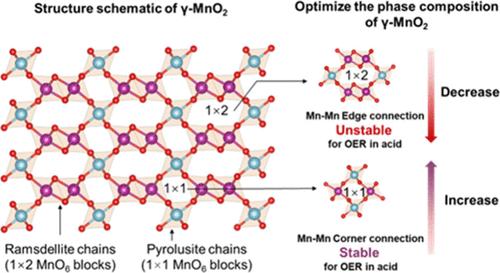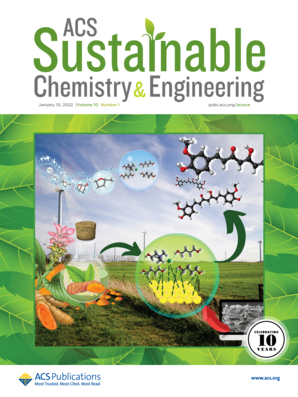Polymorph γ-MnO2 with Optimal Phase Composition for Stable Oxygen Evolution Reaction in Acid
IF 7.3
1区 化学
Q1 CHEMISTRY, MULTIDISCIPLINARY
引用次数: 0
Abstract
The development of non-noble-metal oxygen evolution reaction (OER) electrocatalysts stable in acid to replace rare and expensive iridium catalysts is crucial yet challenging for the large-scale application of proton exchange membrane (PEM) water electrolysis technology. Here, we show that increasing the Pr (pyrolusite ratio) in γ-MnO2 from 73% to 84% results in about 10 times longer durability at a high working current density of 100 mA cm–2 in 1 M H2SO4 for more than 1000 h. Dramatic stability enhancement is due to the inhibition of lattice Mn or O dissolution by leveraging the formation of more stable corner-shared pyrolusite MnO6 octahedra with a higher oxidation state of Mn, fewer defects, a shorter Mn–O bond distance, an increase in stable mono-oxo-bridged Mn–O–Mn pyrolusite MnO6 octahedra, and a decrease in di-oxo-bridged Mn–O2–Mn ramsdellite MnO6 octahedra with more Mn–Mn tension. Because polymorph materials like γ-MnO2 are quite common in nature, phase composition turning may serve as an effective strategy for the development of stable OER catalysts in acidic environments.

具有最佳相组成的多晶体 γ-MnO2 在酸中的稳定氧进化反应
开发在酸中稳定的非贵金属氧进化反应(OER)电催化剂以取代稀有昂贵的铱催化剂,对于质子交换膜(PEM)水电解技术的大规模应用至关重要,但也极具挑战性。在这里,我们展示了将γ-MnO2 中的 Pr(辉绿岩比)从 73% 提高到 84%,可使其在 1 M H2SO4 中 100 mA cm-2 的高工作电流密度下的耐久性延长约 10 倍,持续时间超过 1000 小时。稳定性的显著提高是由于通过形成更稳定的角共享辉绿岩 MnO6 八面体抑制了晶格中 Mn 或 O 的溶解,这些八面体具有更高的 Mn 氧化态、更少的缺陷、更短的 Mn-O 键距离以及更高的 Mn 氧化态、Mn-O键距离更短、稳定的单氧化桥接Mn-O-Mn辉绿岩MnO6八面体增多,以及具有更多Mn-Mn张力的二氧化桥接Mn-O2-Mn苎麻石MnO6八面体减少。由于像 γ-MnO2 这样的多晶体材料在自然界中非常常见,因此相组成的转变可能是开发酸性环境中稳定的 OER 催化剂的有效策略。
本文章由计算机程序翻译,如有差异,请以英文原文为准。
求助全文
约1分钟内获得全文
求助全文
来源期刊

ACS Sustainable Chemistry & Engineering
CHEMISTRY, MULTIDISCIPLINARY-ENGINEERING, CHEMICAL
CiteScore
13.80
自引率
4.80%
发文量
1470
审稿时长
1.7 months
期刊介绍:
ACS Sustainable Chemistry & Engineering is a prestigious weekly peer-reviewed scientific journal published by the American Chemical Society. Dedicated to advancing the principles of green chemistry and green engineering, it covers a wide array of research topics including green chemistry, green engineering, biomass, alternative energy, and life cycle assessment.
The journal welcomes submissions in various formats, including Letters, Articles, Features, and Perspectives (Reviews), that address the challenges of sustainability in the chemical enterprise and contribute to the advancement of sustainable practices. Join us in shaping the future of sustainable chemistry and engineering.
 求助内容:
求助内容: 应助结果提醒方式:
应助结果提醒方式:


